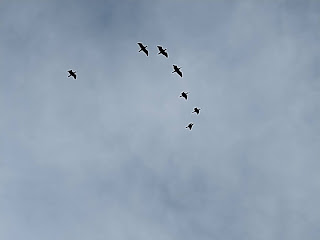Hakone 箱根, one of the most popular National Parks in Japan, has two National Natural Treasures. One is Giant Salamander (Andrias japonicus). It is a Special National Natural Treasure designated in 1952 and lives only in Hakone-en Aquarium. Another is Sengokubara Wetland 仙石原, designated in 1934. Sengokubara is a very famous tourist destination. Especially in autumn, it turns a golden field of pampas grass whose fluffy tufts elegantly swings with chilly winds. To admire it, visitors can walk along Prefectural Road #75, a busy commuter road connecting resort communities spreading around Mt. Hakone. It’s rather difficult to experience ‘wetland’ through Road 75. As the place is National Natural Treasure, real wetland part of Sengokubara is off-limits for tourists. Early October this year, I had a chance to enter wetland of Sengokubara chaperoned by Mr. Teruo Katsuyama 勝山輝男, the Researcher Emeritus for Kanagawa PrefecturalMuseum of Natural History, and the Chairperson for Flora Kanagawa Association. It was a wonderful adventure!
 |
| Having
said that, we can enjoy wild flowers along Road #75 wherever it runs. Hey, we’re in National Park! |
First, the history of Sengokubara Wetland. The place is spreading on the northeast slope of Mt. Daigatake 台ヶ岳. To its north, there is Hayakawa River 早川 that pours into Sagami Bay 相模湾. The wetland was once a large lake created by active volcanic activity of Hakone. It collected water from rains on the surrounding mountains. Sediments were carried by water flow from the higher altitude and gradually deposited at the bottom of the lake. By roughly 5000 years ago, the former lake became Lake Ashinoko 芦ノ湖, wetlands and a river. River is Hayakawa, and Sengokubara was one of the marshes dotted the zone between Lake Ashinoko and Sengokubara area. During the first half of the 20th century, the entire Hakone was for the craze of resort development. Many marshes were reclaimed to build nice vacation houses. The present-day Sengokubara happened to be difficult to build anything, including rice paddies. But it had lots of Japanese Water Iris (Iris ensata). The Sengokubara village chief in 1933, Mr. Kobayashi, thought it would be nice to make it National Nature Treasure for conservation and tourism economy. As Hakone was already famous for rich Tokyoites, he did not have difficulty to find Dr. Miyoshi Manabu 三好学 who spent his summer in Sengokuhara. Dr. Miyoshi was a person in 1919 to establish the Law of Preservation of Historic Sites and Natural Monuments and an expert for Iris. Dr. Miyoshi pushed Sengokubara to the government for a National Natural Monument. At the beginning only 0.7ha of Sengokubara was designated as a Treasure. Later after 1945, farmers who came back from Manchuria were given the surrounding wetlands by the government to try rice cultivation. They all failed and chose to engage in tourism industry instead. The wetland was returned to the national and regional authorities. The space around the original 0.7ha becomes prefectural or otherwise public land and gradually annexed to the Natural Monument.
 |
| In October, all irises were gone to seeds. |
So, the preset-day beautiful field of pampas grass is a patchwork of different kinds of public lands. Anyway, people try to maintain and invigorate the place as a meaningful size of ecosystem as a wetland. Recently, Kanagawa Prefecture acquired surrounding forest of Sengokubara that shields the wetland from urbanization by resort development. Next to the forest is Hakone Botanical Garden of Wetlands 箱根湿生花園 that is owned by Hakone Town. People take care of Garden’s wetland to be a model for restoration of the entire Sengokubara Wetland. We entered the restricted part of Sengokubara from the Botanical Garden. It is a really nice garden worthy of your visit even if only for the area open to the public. The place has well-tended native and otherwise vegetations for temperate mountainous area. The majority of the road inside the Garden is barrier-free so that wheelchair users are able to experience nature of National Treasure. If you have a chance to visit Hakone, please check the place.
 |
| Immediately
after the gate, there is this large map and exhibit what to look inside. |
 |
| This
is one of the ponds inside the Garden. The town maintains the waterflow to keep this place as a pond. More to this, next week. |
 |
| Wood
decks are provided for visitors to stroll the restored wetlands in the Garden. |
 |
| Wild-looking
flowers some of which were actually brought in. More to it, again next week. |
 |
| Strolling paths are wide and barrier-free. |
The access to Botanical Garden is either by car from Gotemba 御殿場 IC of Tomei Expressway, or by bus from Shinjuku (with Odakyu Hakone Expressway Bus 小田急高速バス) or from Odawara (with Hakone-tozan Bus 箱根登山バス, commuter bus services to Kojiri/Togendai 湖尻/桃源台 Terminal; time-table here). You get off your bus at Sengoku An’naijo-mae Stop 仙谷案内所前, walk 20m or so to the north and turn left at the corner of Lalique Museum. From there its one way stroll of less than 10 minutes to the entrance of Botanical Garden. Next week, I tell you my experience at the wetland itself. Please stay tuned. 😉
 |
| Hayakawa River near Sengoku An’naijo-mae Stop |
 |
| The way from Lalique Museum to the Garden is like this. |
Hakone Botanical Garden of Wetlands
817 Sengokubara, Hakone Town, Kanagawa, 250-0631
Phone: 0460-84-7293
https://hakone-shisseikaen.com/








































